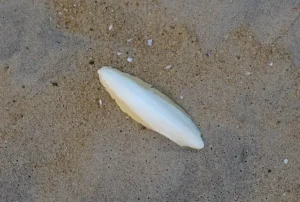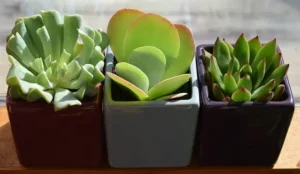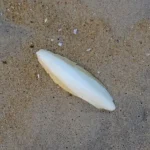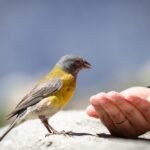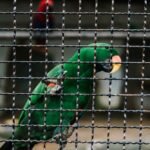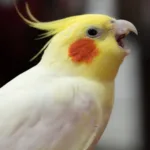Molting is the periodic replacement of feathers that occurs 1-2 times annually in all parrots. It involves the shedding of old feathers to make way for the growth of new ones.
During this time you may find more fallen feathers around the house than usual and the appearance of strange pin-like structures on your parrot’s skin. You may also notice that your parrot is itchy and grumpy.
Parrots undergo a molt at regular intervals to replace their frayed and damaged feathers. As the new feathers start to come out they are shaped like a hollow pin protruding from the parrot’s skin.
These newly growing feathers are also known as “blood feathers” because the quill receives a blood supply during their development. The feather is enriched with nutrients through the blood and once it is matured, the blood supply is sealed off.
In this article, we will discuss the entire molting process, when it occurs, and what you can do to help your parrot during this season.
Quick Navigation
What Causes Molting In Parrots?
The timing and rate of molt are influenced by the amount of daylight parrots receive in their annual cycle and the length of the breeding season.
According to Avian Physiology, it is not known how the body controls the molting process. However, there are some hormones that seem to play a role.
Thyroid hormones, gonadal steroid hormones, and prolactin are all connected to molting. Among them, prolactin is believed to have a more direct influence on the molting process.
Why Do Parrots Molt?
Parrots need to molt to replace worn-out feathers. As a parrot engages in activities like flying, preening, or sometimes even a skirmish with other parrots, feathers can sustain damage from abrasions and injuries.
However, feathers are dead structures made up of keratin, meaning they cannot repair themselves once damaged or worn out.
The process of molting allows these old feathers to be replaced so that the normal functions of the feathers are not compromised.
The purpose of a molt is to maintain the health and functionality of the feathers. Besides the obvious function of flight, feathers serve many other purposes for parrots.
A thick coat of feathers allows parrots to regulate a parrot’s body temperature in colder weather.
Feathers also help parrots to appear more attractive and court potential mates during the breeding season.
When Do Parrots Molt?
Parrots typically molt 1-2 times a year. The timing of their molting can vary depending on the species and environmental factors, but generally, most parrots go through a molt in the fall and one right after summer.
It starts after the breeding season when the warm weather and longer days are over, causing hormonal changes in their bodies.
Parrots also have a partial molt in early-mid winter when they molt the contour feathers.
In captivity, the molting patterns can be slightly inconsistent due to the unnatural lighting and differences in habitat from what parrots are used to experiencing in the wild.
When Do Parrots Have Their First Molt?
Smaller parrots may go through their first molting cycle shortly after they have fledged. Whereas, it may take up to 9-10 months for larger parrots to have their first molt.
The first molt marks an important transition in a young parrot’s development. The feathers undergo a drastic change in which they acquire mature adult colors. If they have any color mutations that will usually show up after the first molt.
How Do Parrots Molt?
During a complete molt, parrots gradually shed feathers – this occurs in a sequence and takes a few weeks. They do not lose all feathers at one time.
The molting process begins with the falling out of primary feathers usually following a sequence from the innermost feathers towards the wingtip.
The central tail feathers are also among the first to shed, followed by the secondary feathers in a similar sequence as the primary feathers.
The timing and sequence of the replacement of contour feathers, however, are not well-documented.
During a partial molt, the contour feathers are usually shed around the same time as the wing feathers, but they may molt at slightly different times on different parts of the bird’s body.
Despite this, the feathers around the body tend to fall out evenly instead of in patches.
Birds also maintain symmetry while molting. When a bird molts wing feathers on one side, it will naturally molt the matching feather on the other wing as well. This is meant to ensure balance and stability during flight.
As the old feathers are falling out, new feathers emerge from a follicle in the bird’s skin. When they are developing, these feathers are covered in a sheath made of keratin.
Initially, these feathers do not look like feathers at all. They appear as small, pin-like structures, which is why they are called pin feathers.
During the growth stage, pin feathers have a hollow shaft that allows the blood supply to flow into them, which helps them to receive the necessary nutrients and pigments to develop fully.
Once the pin feathers are past the early stages of development, the blood supply slowly starts to recede. As the feather continues to grow, the bird will preen it to remove the sheath and reveal the new feather.
How Long Does A Parrot Molt Last?
This again depends on the size and species of the parrot. Smaller parrots may complete their molting cycle in about 4-5 weeks, while the shedding period for larger parrots may be as long as 6 months.
How To Tell If Your Parrot Is Molting
Parrots naturally lose a few feathers every day but if you notice a bit more than that near your parrot’s cage, it may be due to molting. But more fallen feathers may not always indicate molting. You can tell that a parrot is molting by looking at the following signs:
Itching Or Preening More Often
Molting is a natural but uncomfortable process for parrots. The formation of pin feathers can cause parrots to itch. You may see them rubbing their bodies against objects or grooming their feathers more frequently.
Mood Swings
Mood swings during molting can be caused the physical stress, hormonal changes, and irritability.
Lethargy
Molting is also a physically demanding process leaving your parrot enervated and lethargic. You may not see your parrot as lively as before and might see it sleep more often.
Decreased Localisations
Along with being less active, your parrot may also not be willing to scream at the top of its lungs as it takes quite a bit of energy.
Pin Feathers
Pin feathers grow in place of the feathers that are molted. These are naked and hollow shafts with no feathers on them.
Is Your Parrot Molting Or Plucking?
Parrot owners often get alarmed to see feathers falling out suddenly, especially when it is not the molting season. Feather plucking is the last thing anyone would like to deal with. It is a serious problem that may have a myriad of medical and behavioral causes. So it is important to

How To Help A Molting Parrot?
Molting can be a trying time for your parrots and it is essential that you are there for them at this time. Here are some tips to care for your molting parrot:
Allow Your Parrot Some Extra Sleep
Molting is a resource-heavy process that requires a lot of energy and nutrients. When your parrot is going through a molt, it needs more rest to facilitate the growth of new feathers.
Normally, parrots sleep 10-12 hours a day with a couple of short naps in the afternoon. But during the molting season, your parrot may feel the need to stay in bed a little longer.
So make sure your parrot is getting those extra hours of sleep in a dark and undisturbed environment as it is essential for its health and recovery.
Bear With Their Mood Swings
When a parrot is molting, it goes through a lot both physically and hormonally. This can make them feel a bit grumpy at times.
They may not want you to pet them or sometimes might even refuse to play. It is important that you understand your parrot’s changing behavior and comfort them while they’re feeling a little blue.
Provide More Frequent Baths
Parrots can get itchy and uneasy with all the spiky pin feathers breaking out on their skin.
Bathing your parrot during this time is essential, and an effective way to ensure they stay well-moisturized.
Give them regular baths and occasionally mist them with water. This will soothe their skin and also alleviate their itching.
If you live in an area with low humidity, you can spray them using aloe and water solutions. It will keep their skin moisturized for longer.
Incorporate More Protein And Greens
A parrot’s diet influences the quality of the feathers that grow after the molt. If the parrot is not on a proper diet, the feathers may not form properly or appear as bright and healthy.
In some cases, malnutrition can even lead to dull and scruffy-looking feathers. To ensure that your parrot’s plumage grows out even brighter than before, focusing on a nutritious diet is key.
Parrots need a variety of nutrients in their diet including protein, vitamin A, B complex, and several trace minerals.
The protein intake for your parrot needs to significantly go up during molting. This is because feathers are composed of 90 % keratin protein so having enough protein in the diet helps support healthy feather growth.
Along with that, parrots also need carotenoid-rich foods for feather coloration. While parrots get their colors from locally synthesized pigment, Psittacofulvins, carotenoid-rich foods also help in the formation of colorful feathers.
These are some of the foods you can add to your parrot’s diet to have a successful molt:
- Eggs
- Fish
- Quinoa
- Oats
- Nuts
- Sweet potato
- Kale
- Collard Greens
- Carrots
- Spinach
You can learn more about how to improve your parrot’s feather quality in this detailed guide.
Keep Them Warm
The loss of feathers can impair the bird’s ability to regulate its body temperature. To help your parrot keep warm while they regrow their feathers, you can increase the temperature around the house. Parrots like temperatures in the range of 18 to 22 degrees Celsius
Avoid Petting While The Pin Feathers Are Growing
When the pin feathers are initially coming in, they have an active blood supply and can be sensitive to touch.
For this reason, parrots do not like to be pet while molting. Further, excessive petting or handling can actually harm the growing feathers and in some cases lead to a broken blood feather.
Help Them Preen Their Head Feathers
As the pin feathers emerge from the follicles, they are supplied with blood to aid in their growth
Once these feathers have developed, the blood supply recedes, and the keratin sheath surrounding them turns into a flaky straw-like texture that can be preened off.
Your parrot can preen its newly growing feathers on almost all parts of its body, but it may have difficulty reaching the top of its head and the back of its neck.
In the wild, flock mates often assist each other in preening those hard-to-reach areas. However, as pets, parrots may attempt to remove the keratin sheath by rubbing their heads against toys, perches, and other objects if they do not have a cage mate.
So when your parrot is molting, you can help them in preening those areas.
Sometimes a molting parrot won’t allow you to touch it or preen the pin feathers on the head. This is because newly formed pin feathers are very sensitive to touch.
When you’re preening your parrot on the head, run your fingers in the direction the feathers are growing. You can hurt your parrot if you accidentally tug on the pin feathers by preening in the wrong direction.
Is Molting Painful For Parrots?
Molting is not a painful process for parrots, but it can be slightly uncomfortable.
The feathers that fall out are essentially made of dead cells and do not have a blood supply, so they come out easily from the follicles.
However, when new “pin” feathers start growing and break through the skin, birds may feel some mild discomfort.
These pin feathers initially have a blood supply while they are growing, which can make them sensitive to touch.
Is Molting Stressful For Parrots?
Molting is extremely stressful and physically draining for parrots. The growth of new feathers takes more nutrients from their body and makes them sluggish. Also, the pointy pin feathers do not make it easy for parrots. They can cause constant itching and make them irritable.

